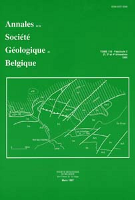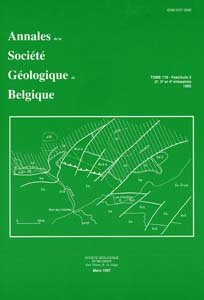- Home
- Volume 120 (1997)
- Fascicule 1
- A review of the Ordovician acritarchs Aureotesta and Marrocanium
View(s): 737 (25 ULiège)
Download(s): 1100 (54 ULiège)
A review of the Ordovician acritarchs Aureotesta and Marrocanium

Résumé
Les deux genres monospécifiques d'acritarches de l'Ordovicien Aureotesta Vavrdovâ 1972 et Marrocanium Cramer et al. 1974 ont été étudiés à partir d'assemblages bien préservés de Bohème, de Chine et du Maroc. Une très grande variabilité a été observée dans tous les échantillons analysés et une transition graduelle entre les deux taxons est documentée. La différenciation de deux genres distincts, telle qu'utilisée jusqu'à présent, n'est plus justifiée, parce que les deux morphotypes et des spécimens intermédiaires ont été observés dans la même population. La conséquence logique de cette observation est de classer tous les spécimens sous un seul nom de taxon: Aureotesta clathrata emend. Les pôles extrêmes de la population peuvent être classés au niveau de variété: Aureotesta clathrata var. clathrata et Aureotesta clathrata var. simplex. Le taxon Aureotesta clathrata est d'une grande importance biostratigraphique et paléobiogéographique. Sa première apparition est dans la Biozone à Corymbograptus v-similis en Bohème et dans la Biozone à Didymograptus deflexus en Chine du Sud. Sa distribution paléogéographique est limitée à la paléoprovince froide à tempérée de Gondwana et de péri-Gondwana, "paléoprovince méditerranéenne", située pendant l'Ordovicien inférieur dans les régions de hautes latitutes de l'hémisphère sud.
Abstract
The two monospecific Ordovician acritarch genera Aureotesta Vavrdová 1972 and Marrocanium Cramer et al. 1974 are investigated in well preserved assemblages from Bohemia, China and Morocco. A high variability is observed in each of the investigated samples and a gradual transition between the two taxa is documented. The differentiation of two distinct genera, as used up to the present, is no longer justified, because both morphotypes and transitional forms occur in the same population. The logical consequence of this observation is the classification of all specimens under one single taxon name: Aureotesta clathrata emend. The extreme poles of the population are classified at the varietas level: Aureotesta clathrata var. clathrata and Aureotesta clathrata var. simplex.
The easily discernible taxon Aureotesta clathrata is of great biostratigraphical and palaeobiogeographical importance. Its First Appearance Datum (FAD) is in the Corymbograptus v-similis Biozone in Bohemia and in the Didymograptus deflexus Biozone in South China. Palaeobiogeographically, its distribution is limited to the cold to temperate Gondwanan and peri-Gondwanan ("Mediterranean") "Palaeoprovince", located during the Early Ordovician at high latitudes in the southern hemisphere.






